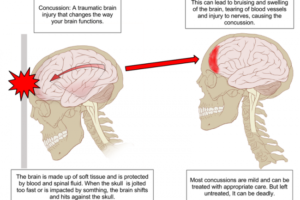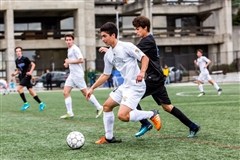On January 7, Cam Newton, the Carolina Panthers quarterback, suffered a brutal hit while playing in a game against the New Orleans Saints. After the hit, Newton stumbled to the sidelines and collapsed suddenly to his knees. Newton was helped off the field, where he was ushered to a medical tent with what many saw as the clear signs of an obvious concussion. Yet, in less than seven minutes, he was cleared to play and returned to the field. While his prompt return aroused immediate applause from fans, it also added fire to the ongoing discussion around player safety.
Newton’s return to the field after his fall caused many to question whether the team had followed NFL protocol. The league’s official protocol says that a player “who stumbles and/or falls to the ground when trying to stand, unrelated to an orthopedic injury, should be sent directly to the locker room to undergo the standard locker room exam.” Newton later blamed his stumble on an eye injury, claiming he had fallen as a result of being poked in the eye.
While the NFL has publicly pushed for more stringent player protections, these rules are often ignored for big-name players in big games. Even when the league fines teams in these situations, the fines don’t create much of a deterrent, as the profits from the games far outweigh the reparations. In other words, it is more economically prudent to keep a concussed player in to win a game than to pull him and avoid the ensuing sanctions.

The controversy around concussions is not limited to the NFL. Concussions are increasingly a worry in all sports, particularly youth sports. These head injuries are very dangerous and even be fatal if severe enough. Suffering a second concussion while still recovering from a first can lead to serious brain damage, which means that it is of the utmost importance to diagnose concussions when they happen and to keep players safe while they recover. Brain damage caused by concussions can last for decades after the concussion happens, as is becoming increasingly clear through studying former NFL players after retirement. The temporary symptoms of concussions include loss of brain function, confusion, vomiting, headache, nausea, depression, fitful sleep, moodiness and troubles with memory. However, damage can remain even after these symptoms disappear. Older athletes who have suffered extensive brain damage from recurring brain trauma show similar symptoms to those suffering from Parkinson’s Disease and Alzheimer’s, and face difficulty paying and sustaining attention.
High schools are especially hard pressed to protect their players while also allowing them to compete at the highest level possible. Lick-Wilmerding trainer, Dee Allen, says she sees an average of five to eight students suffered a concussion-related to school sports each year. These head injuries are evenly distributed across men’s and women’s sports, as well as across all sports, although more occur in contact sports. At Lick, if a player is suspected of having a concussion, they are supposed to go to a doctor to be evaluated, Allen reported, “so that they can get a note from their doctor in case they need more time for school work or tests. In addition, they must start to follow the ‘return to play protocol’” – the guidelines outlining the steps a player needs to go through in order to safely return to play after a concussion.
Allen adds that while “there is no definitive way to diagnose having a concussion, nausea, headaches, lack of focus, irritation to light and computer stimulus” are all good warning signs of a concussion. At the beginning of each season, Lick players take a baseline concussion test to which their scores can be compared if they show signs of a concussion Lick looks for concussions whenever someone gets hit in the head and feels woozy, wobbly, headache-y, or doesn’t feel like their normal self. The coach must pull them out of the game so they can take a minute and see how they feel and if they start feeling any symptoms.

Emily Rupright ‘18 suffered a minor concussion earlier this year after a girl sat on her head as she dove for a ball in a basketball game, smacking her head upon the court. Afterwards, there was a general consensus among those watching that Rupright had a concussion, as she was “crying and obviously shaken up”. Rupright remembered that, “I had a headache that lasted like three days and got lighter and more on and off as days passed. The most noticeable symptom was that I was exhausted and took long naps like four days in a row after it happened.” She retook the concussion test and received a slightly lower score, signifying a mild concussion. After these results, she then went to see her doctor for an official diagnosis.

Yasmeena Khan ‘18 was also diagnosed with a concussion following participation in Lick sports. During her tennis season two years ago she was hit by the racket of a teammate prepping for a serve. Spencer Yu, the Assistant Athletic Director, suspected Khan of a concussion after she failed to answer his short term memory questions. She then retook the concussion test and “performed significantly worse on the memory section,” Khan recalls, “I was officially diagnosed by the doctor on call at the urgent care center near my house.” While concussed, Khan suffered migraines, issues with short term memory and nausea.

In a soccer game a few weeks ago, Alex Koh-Bell ‘18 went for a header and hit heads with a player on the opposing team. He remembers, “I felt a little out of it for the next five minutes or so but then I felt fine for the rest of the game, and didn’t think about it at all. I was more tired than usual that night and had some sensitivity to noise, which are both symptoms of concussions, but I didn’t know that at the time. The next day, I looked up concussion symptoms and talked to my mom who is a doctor about it and I figured out I had a concussion. My main symptom was being tired and unable to focus.”
While Lick seems to be following its protocol, room for improvement and expansion remains. Dr. Audrey Koh, a doctor at the California Pacific Medical Center and parent to Alex Koh-Bell, offered suggestions to improve Lick’s concussion protocol following her son’s injury. She said she didn’t know Lick even had a protocol, which is a big part of the problem. She believes Lick should have a written up agreement which is sent out to parents at the start of each season that their child competes in a school sport. While big concussions are usually obvious, it’s the mild concussions that are often most dangerous as players, parents and coaches are often unaware of the symptoms. This issue can be solved with increased education aimed at making all participants and spectators of Lick sports more aware of the what to look out for in players. Koh offered another suggestion, advising that the baseline concussion test Lick gives to freshman should be taken by all participants each year, and that results should be more readily accessible to coaches in order to better re-evaluate players after impact.






